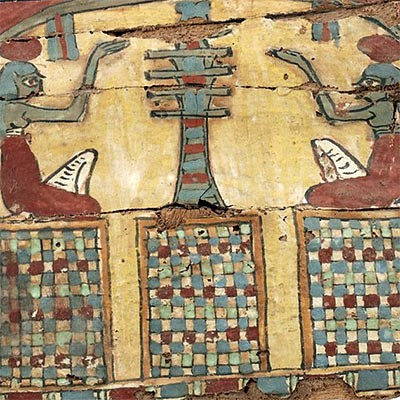Egyptian Wood Coffin Panel Inscribed Hieroglyphs
Lot 7
About Seller
Artemis Fine Arts
686 S Taylor Ave, Ste 106
Louisville, CO 80027
United States
Selling antiquities, ancient and ethnographic art online since 1993, Artemis Gallery specializes in Classical Antiquities (Egyptian, Greek, Roman, Near Eastern), Asian, Pre-Columbian, African / Tribal / Oceanographic art. Our extensive inventory includes pottery, stone, metal, wood, glass and textil...Read more
Categories
Estimate:
$2,800 - $5,000
Absentee vs Live bid
Two ways to bid:
- Leave a max absentee bid and the platform will bid on your behalf up to your maximum bid during the live auction.
- Bid live during the auction and your bids will be submitted real-time to the auctioneer.
Bid Increments
| Price | Bid Increment |
|---|---|
| $0 | $25 |
| $300 | $50 |
| $1,000 | $100 |
| $2,000 | $250 |
| $5,000 | $500 |
| $10,000 | $1,000 |
| $20,000 | $2,500 |
| $50,000 | $5,000 |
| $100,000 | $10,000 |
| $200,000 | $20,000 |
About Auction
By Artemis Fine Arts
Jul 30, 2020
Set Reminder
2020-07-30 10:00:00
2020-07-30 10:00:00
America/New_York
Bidsquare
Bidsquare : Ancient / Ethnographic From Around the World
https://www.bidsquare.com/auctions/artemis-gallery/ancient-ethnographic-from-around-the-world-5382
Ancient art from Egypt, Greece, Italy and the Near East, as well as Asian, Pre-Columbian, Native American, African / Tribal / Oceanic, Spanish Colonial, Russian Icons, Fine art, much more! All categories, all price ranges... all legally acquired and guaranteed to be as described or your money back. Artemis Fine Arts info@artemisgallery.com
Ancient art from Egypt, Greece, Italy and the Near East, as well as Asian, Pre-Columbian, Native American, African / Tribal / Oceanic, Spanish Colonial, Russian Icons, Fine art, much more! All categories, all price ranges... all legally acquired and guaranteed to be as described or your money back. Artemis Fine Arts info@artemisgallery.com
- Lot Description
Egypt, Late Dynastic Period, 26th to 31st Dynasty, ca. 664 to 332 BCE. A lengthy rectangular panel fragment from an anthropoid coffin carved from dense hardwood. One side of the panel features a single column of inscribed hieroglyphic symbols including a standing bird, a five-pointed star, and a rippling body of water above a domed bowl; this was perhaps meant to be displayed on the exterior of the coffin. Exhibited on the reverse side - meant as the interior coffin walls - are thirty-five partial columns of inscribed hieroglyphs that, while untranslated, likely provide protective incantations, offerings for the deceased, and instructions on how to pass unabated into the afterlife. Remains of several mortises and dowels are visible along the upper and lower peripheries, and fine patina has formed across the entire fragment. Size: 28.75" L x 5.625" W (73 cm x 14.3 cm)
Anthropoid coffins first appeared during the Middle Kingdom era - skillfully carved so as to outline the mummy's body and decorated with the visage and wig of the deceased individual. Such coffins not only served to copy the mummy's form kept within, but also as actual substitutes for the bodies in the event that the body of the deceased was lost or destroyed. As time progressed, these coffins were decorated with more extensive iconographic and hieroglyphic programs, presenting a greater number of inscriptions as we see in this example.
Provenance: private J.H. collection, Beaverton, Oregon, USA, acquired in 2005; ex-private eBay seller, Sugar Land, Texas, USA
All items legal to buy/sell under U.S. Statute covering cultural patrimony Code 2600, CHAPTER 14, and are guaranteed to be as described or your money back.
A Certificate of Authenticity will accompany all winning bids.
We ship worldwide and handle all shipping in-house for your convenience.
#151068This is a fragment of a larger wooden coffin. Losses to some peripheral areas, parts of original dowels, and some hieroglyphic symbols as shown. Minor splintering in some areas, with light softening to some inscribed hieroglyphs, and light encrustations within some recessed areas. Great patina throughout, and many original hieroglyphs are still visible and clear.Condition
- Shipping Info
-
All shipping is handled in-house for your convenience. Your invoice from Artemis Gallery will include shipping calculation instructions. If in doubt, please inquire BEFORE bidding for estimated shipping costs for individual items.
-
- Buyer's Premium



 EUR
EUR CAD
CAD AUD
AUD GBP
GBP MXN
MXN HKD
HKD CNY
CNY MYR
MYR SEK
SEK SGD
SGD CHF
CHF THB
THB















